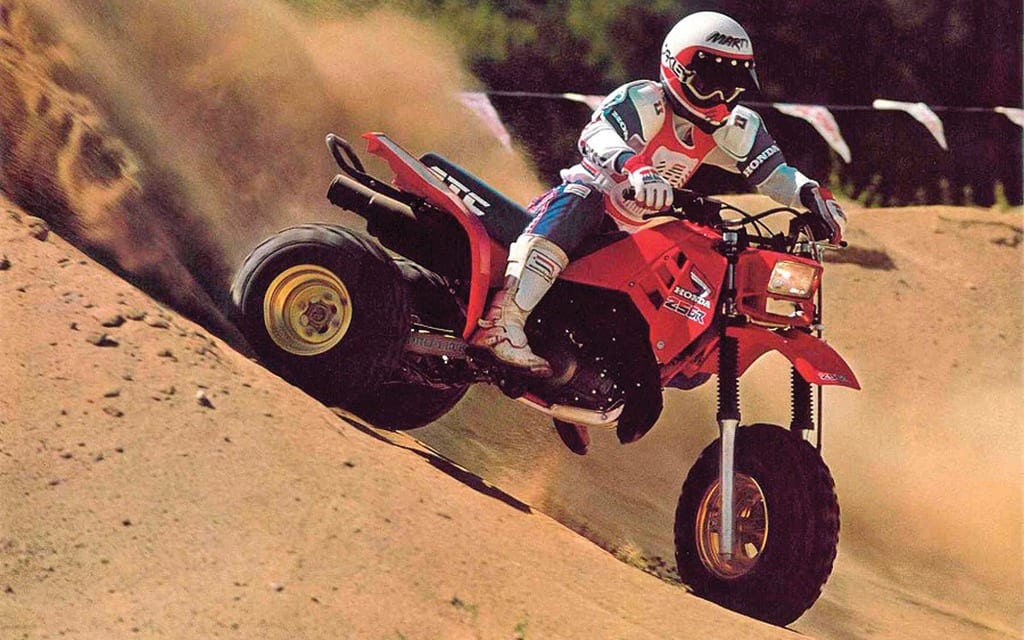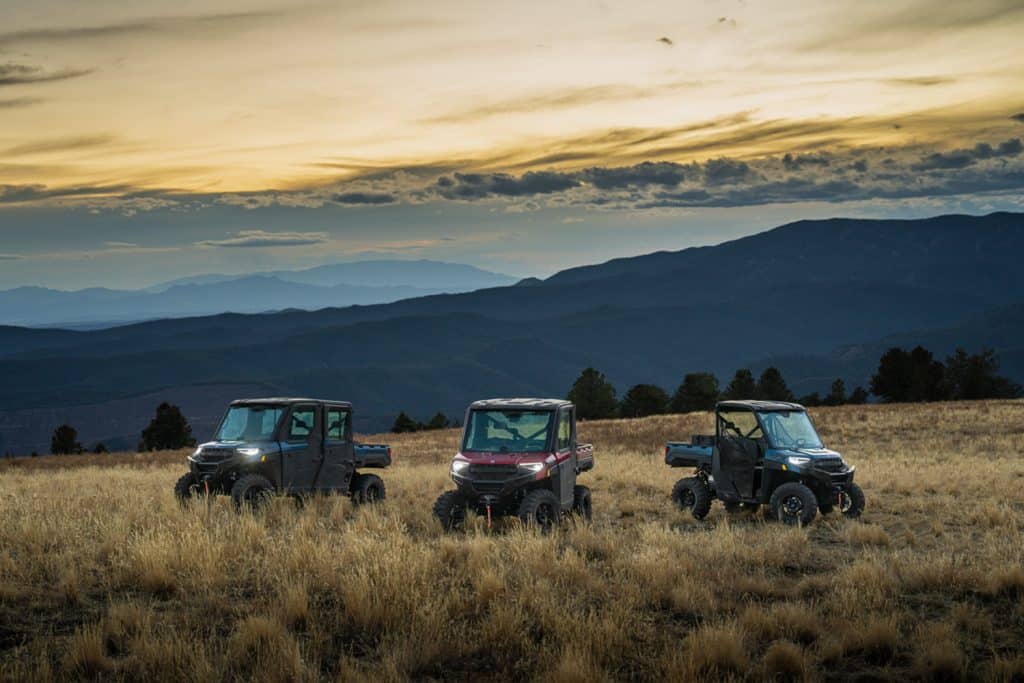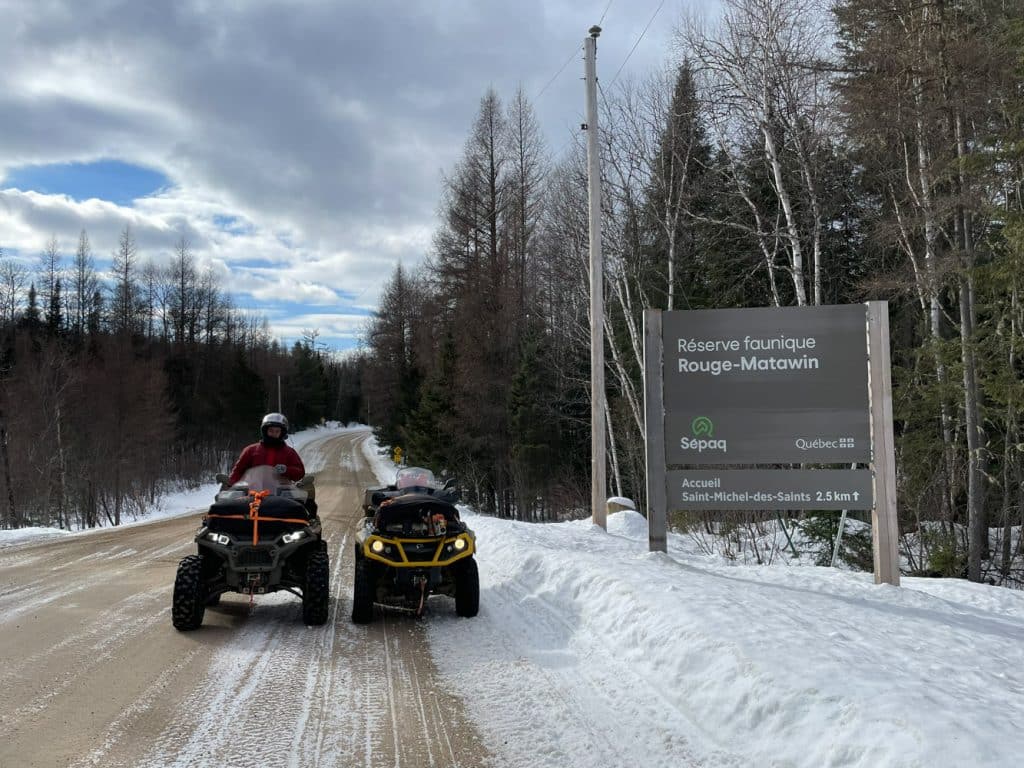Top Ten Honda ATVs in History, no company in the history of ATVs has had more influence than Honda. Other than a few six or eight wheeled amphibious vehicles that found a niche with sportsman and work crews for their ability to traverse wet or dry terrain, it was the cute, little trike, the 1970 model ATC 90 that grabbed immediate acceptance and launched a sport. Suddenly those that were intimidated by riding a motorcycle offroad had another option, and even British secret agent James Bond hopped on an ATC 90. Honda had started an industry! Now four decades since, a handful of the original ATCs are still running, but it is far from the only ground breaking model from Big Red and it all began with a small team and a dream.
1967 – The Dream Team
Honda had a problem, not with their motorcycles, but with the weather. Specifically, when the weather turns nasty for either a day or an entire season, motorcycles get left in the garage. A vehicle concept team led by Honda engineer Osamu Takeuchi was formed in 1967 to see what could be done, and since altering the weather was out of reach they opted to create a year round vehicle designed to pick up slack sales in the off-season. All types of vehicles were examined and tested, including an American invention called the Amphi-Cat® that rolled on six, 20-inch low-pressure, high-flotation balloon tires. Sound familiar? Soon it was determined that a three-wheeled vehicle delivered the best possibility for its ability to operate in sand, snow, mud, and any other slippery surface, thanks to a 22-inch low pressure tire. Since this was an all-new vehicle exhaustive testing was done on everything from stability, to foot peg placement, to the use of an all-new thumb throttle. With no other model to go on, Honda engineers were essentially inventing the wheel, or more accurately, three of them. A rear differential was considered, but discarded when a live axle performed better, and although full suspension is an integral part of the modern ATV, Takeuchi’s original balloon tires soaked up rough terrain best. An added benefit is less ground pressure, which let the little ATC 90 go where others couldn’t and after an estimated 6.5 million sales in various configurations over nearly 30 years the ATC DNA can be found in every one of Honda’s groundbreaking ATVs since. Here is our pick for Honda’s top ten most influential models. They may not have all been sales leaders, but with innovation they changed the direction of the industry.
No.1 – The 1970 ATC 90 – The start of an industry
Officially introduced to America in 1970 as the $595 US90, the machine was based on an 89cc single cylinder engine that sent its 7 horsepower through a dual-range four-speed gearbox with automatic clutch. A big feature was called Swivel-Lok™ which allowed for quick handlebar removal for easy loading in a trunk or a station wagon. (Remember those?) Later that year the US90 was renamed the ATC90 when Honda trademarked the ATC name, and three models carried that Honda ATC monogram through the 1970s. The ATC70 gave younger riders a scaled-down version of the fat-tire experience. And by the end of the decade, requests for more power turned the original ATC90 into the ATC110 in 1979. The ATC was as evolutionary as it was revolutionary from the beginning.
Good as the original fat tires were on snow and sand, they were vulnerable to punctures from things such as stubble from harvested crops. The fact that those original tires weren’t repairable compounded the problem, so a fabric carcass was added, and steel hubs replaced the first hubless wheel design in 1975. Tougher, color-impregnated plastic fenders were added in 1975 as well.
Though it was primarily a recreational vehicle through the ’70s, farmers were beginning to see the ATC as a tool to make their lives easier. Honda engineers followed their machines into the field, gathering data to guide the machine’s natural adaptation to a rapidly growing market. The ATC was as capable at labor as at leisure, and America was catching on to the loveable ATC.
No.2 – The 1982 ATC200E – Meet Big Red
This is the ATV that kicked off a whole new segment. Designed as the first true utility ATV, the 1982 ATC200E, a.k.a. Big Red®, had more of everything necessary to get a host of jobs done and they found their way to every farm, ranch, and construction site in the country. Its 192cc engine cranked out more power than any ATV before it, especially low in the powerband, making chores such as towing, spraying, seeding and fertilizing easier. An electric starter made starting simple, and a dual-range five-speed semi-automatic transmission got the power to the ground, while front and rear racks and a 9.2-liter storage box could handle all the tools and camping gear you could pile on them. A new, sealed rear drum brake survived the muddy fields and water crossings, and telescopic-fork front suspension made a day in the saddle that much more comfortable. Big Red added a reverse gear in 1984, and its drive chain was replaced with shaft drive for extra durability and less maintenance. A new industry segment was born and the Honda MUV proudly carried on the Big Red name.
No.3 – The 1984 TRX200 – The first Honda four-wheeler
Honda’s research made it clear that the next step in the ATV’s evolution would be another wheel. Thus Honda’s first four-wheel ATV, the TRX200, debuted in 1984. The TRX200 was powered by a durable single-cylinder four-stroke engine running through a five-speed dual-range transmission with shaft drive and Reverse. Front and rear racks make it an indispensable tool for thousands of jobs, and the market responded almost immediately, making 1984 Honda’s biggest sales year for ATVs. The 370,000 units delivered in 1984 remain the high-water mark for Honda ATV sales, making up a full 69 percent of total ATV sales in the U.S. that year. The upswing in utility use and the introduction of the four-wheel TRX200 were also the beginning of the end for Takeuchi’s three-wheel matrix. Four-wheelers were considered more versatile tools by customers, and tools were what people wanted most. They were easy to ride and capable whether at play on the weekend or at work on the farm during the week. The tide had turned and four wheels would be the future.
No.4 – The 1988 FourTrax 300 4×4 – Sales leader
On the eve of the ’90s, Honda introduced the 1988 FourTrax 300 and FourTrax 300 4×4, the revolutionary pair of hard-working Hondas that would ultimately become the most versatile, most popular ATVs in history. Combining an ideal balance of size, weight, power and capacity, the 300s sold more than 530,000 units over the ensuing 12 years. Powered by a 282cc air-cooled four-stroke single-cylinder engine, the FourTrax 300 sent its 20 horsepower through a five-speed transmission, automatic clutch and maintenance-free shaft drive. Full-time four-wheel drive, double-wishbone front suspension, a limited-slip front differential, and an ultra-low first gear helped it tow up to 850 pounds. Tough steel racks let it carry up to 66 pounds in front and 132 pounds in the rear. And if the hardest-working ATV in America ended up packing tackle to your favorite bass fishing spot on Saturday morning, nobody else had to know.
No.5 – The 1987 FourTrax Foreman 4×4 – Job site leader
Building on the highly successful, hard working FourTrax 350 4×4, the celebrated Foreman® name is born. The 350cc Foreman 4×4 features front and rear racks, a high-output, 310-watt alternator, and an 850-pound towing capacity. This powerful workhorse is equipped with a tough 350cc four-stroke engine, a vibration-reducing counterbalancer and a fan-assisted oil cooler as standard equipment, and its Honda’s first ATV with full-time four-wheel drive and a limited-slip front differential. The FourTrax Foreman would have a long run in the Honda lineup however.
The 1995 Foreman 400 4×4 introduced the working world to the innovative longitudinal engine design that positions the crankshaft perpendicular to its axles. The ’95 Foreman’s front and rear drive shafts transfer power to all four wheels with fewer power-robbing directional changes, fewer parts, less weight and a lower center of mass.
In 1998 Honda delivered two versions of the Foreman: the manual-shift Foreman S and the electric-shift Foreman ES. Honda’s Electric Shift Program (ESP™) gearbox offers the convenience of an automatic transmission with the durability and engine braking of a conventional transmission, allowing riders to shift up or down with the push of a button. Three years later the 2001 FourTrax Foreman Rubicon takes things one step further with the four-valve liquid-cooled 500cc single-cylinder four-stroke Rubicon™ equipped with the revolutionary new Hondamatic™ automatic transmission. The Hondamatic is compact, quiet, rugged, maintenance-free and sealed against external contaminants, and it features engine braking. Honda’s most powerful multipurpose ATV, the Rubicon features many innovative design features found on its siblings: longitudinally mounted, dry-sump OHV engine; torque-sensing front differential; and ESP-controlled shifting in addition to the automatic shifting modes. Regardless of the model, the Foreman is ready to go to work.
No.6 – The 1986 FourTrax 250R – Legend in the making
The ground-breaking Honda FourTrax 250R (also called the TRX250R) made an unmatched four-wheel performance statement when it was released in 1986. It quickly became the definitive high-performance ATV and traces of its influence can be found in every hi-performance ATV today. Equipped with a liquid-cooled, 246cc, counterbalanced, two-stroke single-cylinder engine, six-speed close-ratio manual transmission, fully adjustable front and rear suspension and triple disc brakes, the 328-pound 250R was designed for expert riders seeking the ultimate sport/competition ATV. Its forte was handling however and comfortable ergonomics and predictable handling across even the roughest terrain made it an instant winner on the track, and a blast on the dunes. In 1988 Honda refined frame geometry, shortened the swingarm an inch, and gave the engine a new cylinder and gear specs further increasing its dominance, but at the end of ’89 it was gone. Sport riders had seemingly been abandoned by corporate Honda, but they loved the machine and the legend of the 250R was born.
No.7 – The Rancher Lineup
Improving the single most popular ATV model, the FourTrax 300 series, was a truly difficult undertaking, but the Rancher lineup achieved just that. Putting the compact, powerful efficiency of the 329cc longitudinal-powered drive train in an all-new chassis creates a better version of what was arguably the most versatile multipurpose ATV ever created.
The four model year 2000 Ranchers – 2WD and 4WD, conventional or ESP-controlled electric shifting—replaced the ever-popular FourTrax 300s. Four-wheel-drive versions feature a new torque-sensing front differential that sends power to the wheel with the most traction. The Rancher engine utilizes Honda’s longitudinally mounted engine design, and its height is further reduced by a dry-sump lubrication system carrying oil in a separate tank inside the engine cases. With more ground clearance and an even lower center of gravity, the multipurpose Ranchers handle excellent.
The 2007 model Ranchers are completely redesigned and equipped with a fuel-injected, liquid-cooled 420cc engine. All four variations—2WD manual or ESP (electric shifting), 4WD manual or ESP—feature a longitudinally mounted engine for maximum drivetrain efficiency, low center of gravity for ease of maneuverability, beefy cooling system, super-heavy-duty automatic clutch, powerful 343-watt AC generator, corrosion-resistant stainless-steel exhaust header and muffler and front wheel disc brakes. Four-wheel-drive versions also offer TraxLok for selectable 4WD/2WD operation.
The immensely popular FourTrax Rancher lineup again grows in 2009 with the debut of a new Honda automatic transmission that provides five-speed auto-shifting or push-button manual gear selection. Available with EPS or conventional manual steering these two models also boast a new double-wishbone Independent Rear Suspension for class-leading handling, plus disc brakes front and rear.
No.8 – The 1999 FourTrax 400EX – Back to the Track!
Honda’s first high-performance ATV in more than ten years immediately awakens and electrifies the starving ATV sport industry. Using an XR400-derived four-stroke powerplant and a cast-aluminum swingarm—another industry first—the 374-pound 400EX is an instant success on the showroom floor and at the track. Reportedly, demand was so high in their first year of production a second production run was added, and overnight the 400EX was at every ride area and race track in the country. On the track or trail handling was outstanding, reliability was very good, and it was extremely comfortable. Most importantly however it was a serious new sport machine from Honda that the public had been begging for since the last TRX 250R reached the end of the line in 1989. Honda was back!
No.9 – The 1983 ATC 200X – Best trail buddy ever
ATC sales are booming when Honda introduces this XR-type high-performance, single-cylinder four-stroke with full suspension and lightweight aluminum wheels. Honda’s reputation for performance and durability makes the 282-pound 200X one of the industry’s most successful sport ATVs and countless new riders experience the joy of offroading for the first time on the easy to ride, great handling ATC 200X. Equipped with a 192cc 4 stroke engine, five-speed gearbox and manual, motorcycle-style clutch with long-travel suspension and sporty chassis geometry, the 200X is more at home on the dunes, trail or track than on the farm, and sport riders find one of their best trail riding buddies ever. We still own the 1986 model and it’s as reliable and fun today as it ever was.
No.10 – The 1985 ATC 250R – Performance like nothing before
ATC racing was hot in the ’80s everywhere from frozen lakes in the East to Western deserts to the dirt ovals of Middle America. Honda was first to the track with their performance leader, the 1981 ATC250R but it was the 1985 model ATC250R that really grabbed you by the shorts. That model is our Editor’s all-time favorite vehicle ever built and he would have surely put it in the #1 spot.
The high-performance world was rocked by the introduction of the most advanced three-wheeler ever known. With a 246cc reed-valve induction, liquid-cooled single-cylinder two-stroke with gear-driven counterbalancer, the Baja-proven mill pumped out 38 horsepower (40 percent more than previous models) through a six-speed gearbox and was cooled by two aluminum radiators. The 39mm air-adjustable front forks, adjustable Pro-Link rear suspension with nearly 10 inches of travel, aluminum wheels and disc brakes were state-of-the-art, and factory rider Marty Hart was the man to beat. Few riders ever did.
A WING AND A PRAYER
Since the early days of their ATV program, no other company has played a greater role in the formation of the sport than Honda, although that has fallen off dramatically in recent years as strong, aggressive competitors have repeatedly introduced models with more power, features, and performance. That has led many to wonder what they’ve been doing for the past half-decade or so, and the universal hope is that Honda breaks open that big bottle of Red Pixie dust and gets back to their roots. If their track record has taught us anything, with a little will and imagination it could be very exciting!





